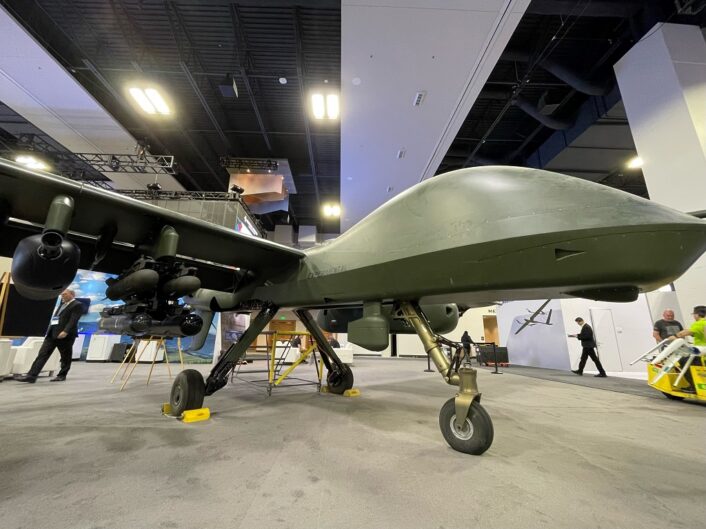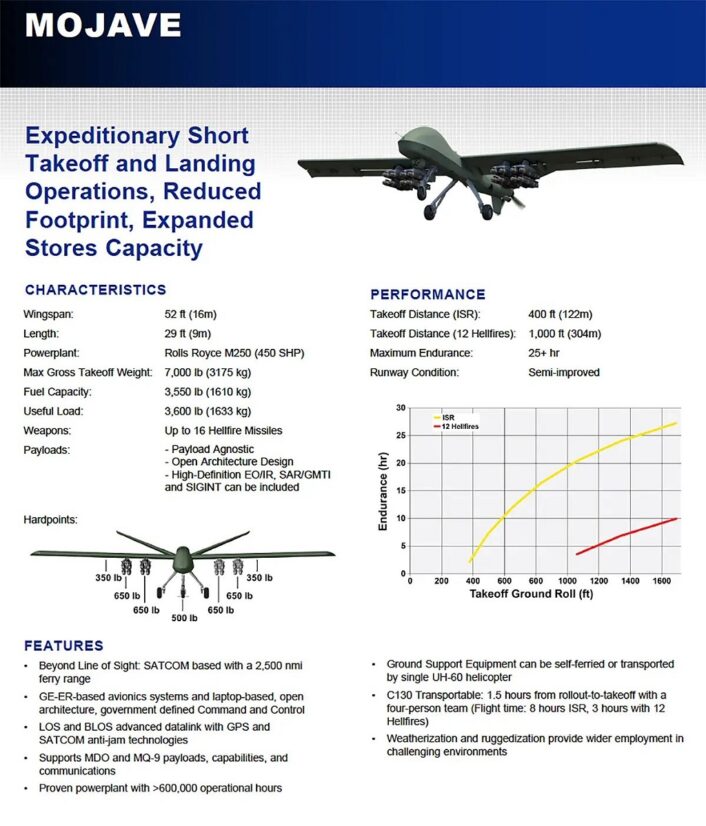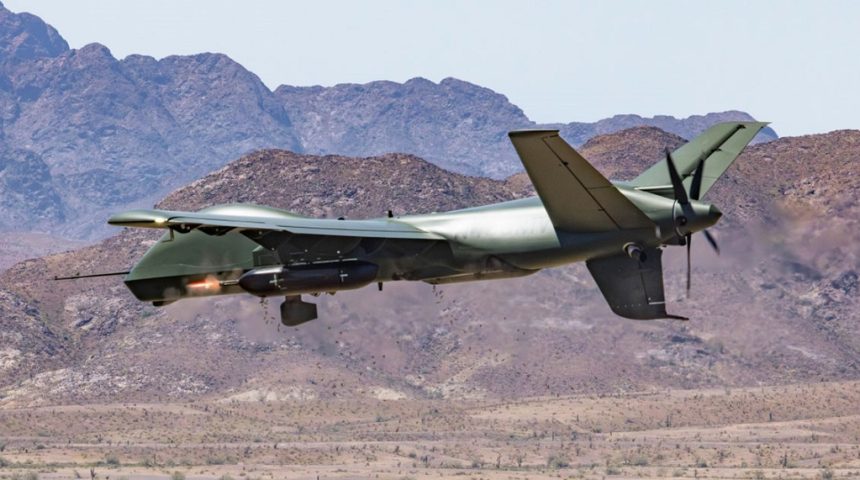The drone strafed targets on the ground during a live fire event earlier this month.
General Atomics announced the successful testing of the Mojave Unmanned Aircraft System, equipped with M134 7.62 miniguns, which destroyed static targets in live-fire tests on April 13, 2024. GA-ASI partnered with Dillon Aero to mount two of Dillon’s DAP-6 Gun Pod Systems onto the Mojave aircraft, representing the first time such a weapon is installed on an unmanned aircraft.
The DAP-6 Gun Pod System is a self-contained M134D-H weapon system that can be mounted to either fixed-wing or rotary-wing aircraft. The pod has a 3,000-round magazine capacity and utilizes 7.62x51mm NATO ammunition with M13 links, firing 3,000 rounds per minute.
The live-fire demonstration took place at Yuma Proving Ground, Arizona, and was funded via GA-ASI’s internal research and development budget. Mojave performed seven passes across two flights during the demonstration, expending around 10,000 rounds of ammunition as the UAS shredded a variety of targets.
#MojaveUAS once again proves its unmatched versatility: using two Dillon Aero DAP-6 gun pods, it destroyed multiple static targets in a live-fire test. #AAAA2024
See Mojave in action and read about our recent test: https://t.co/rGVewJL9JZ pic.twitter.com/6d3m3ZMifw
— GA-ASI (@GenAtomics_ASI) April 23, 2024
The successful test allowed to validate the system’s battlefield relevance and record another milestone for the demonstrator aircraft, according to the company. This adds to the multiple milestones of the Mojave, including rough-field and dirt short takeoff and landing operations and the flight operations from the Royal Navy’s HMS Prince of Wales aircraft carrier last year.
“Seeing our Mojave perform this live-fire demo really emphasizes the versatility of the Mojave UAS and what it can do,” said GA-ASI President David R. Alexander. “Mojave has the ability to act as a sensor, shooter, and sustainer while mitigating threat environments and vulnerabilities and safeguarding human lives.”
The flights not only reaffirmed that Mojave can take on any number of new missions with a relatively short and simple period of engineering integration, said General Atomics, they confirmed that the aircraft’s remote pilots can use it to attack at low altitudes. GA-ASI test engineers worked with Dillon Aero’s armorers and aeronautical specialists to integrate the gun pods, validating that Mojave could take on virtually any new payload.
#MojaveUAS offers an unmatched contested logistics capability that can deliver 1000 lb of critical supplies and rapidly redeploy without additional ground support. #AAAA2024 pic.twitter.com/8vCoWzUZmY
— GA-ASI (@GenAtomics_ASI) April 23, 2024
“We’ve been flying medium-altitude, long-endurance unmanned systems for a long time, and they have used munitions against both air and surface targets. But usually, those munitions break away from the aircraft and close the distance using their own onboard guidance electronics and propulsion,” said a GA-ASI engineer involved with the tests. “With these flights we’ve shown these aircraft also can shoot many unguided rounds, if they need to, and put them where they need to go.”
The Mojave Remotely Piloted Aircraft System and Gray Eagle STOL
The Mojave is a Short Take Off and Landing (STOL) Medium Altitude Long Endurance (MALE) RPAS that General Atomics developed from the MQ-1C Gray Eagle-Extended Range. General Atomics describes Mojave as a slightly modified version of Gray Eagle.
The objective was to create a drone suited for expeditionary operations from forward-bases without the need for typical paved runways or infrastructure. Because of this, Mojave has a different wing and tail assembly and sacrifices some airborne endurance in order to reduce ground roll for takeoff and landing as compared with the legacy aircraft.

Like the Gray Eagle ER, Mojave can be equipped with a sensor suite including EO/IR, Synthetic Aperture Radar/Ground Moving Target Indicator (SAR/GMTI) and Signal Intelligence (SIGINT) to support land or maritime missions. However, its payload is doubled compared to the Gray Eagle as its increased wing surface area allows it to carry up to 3,600 lb (1,633 kg), which totals as many as 16 AGM-114 Hellfire missiles.
General Atomics further mentions the aircraft represents a low-risk bridge for the U.S. Army or other users to get from the familiar, existing Gray Eagle to a new Gray Eagle STOL configuration. In addition to being a proven system, the Gray Eagle STOL now offers both runway and full-featured onboard sensing and communications and highly relevant range and endurance.
Combat airpower assembled in 90 minutes.#MojaveUAS is designed for rapid tactical deployments in austere environments.
Learn how: https://t.co/uaJvjtzBAz pic.twitter.com/PUQmLEcvPx
— GA-ASI (@GenAtomics_ASI) April 18, 2024
The company also envisions the Gray Eagle STOL as a way to tackle the problem of contested logistics. General Atomics released a short video showing the mission concept, with the UAS using two cargo pods to deliver 1,000 lb for 500 km and then rapidly redeploy without additional ground support.
“Gray Eagle STOL might fly from a friendly airbase equipped with cargo for friendly forces as well as air-to-ground weapons,” says the company. “During its flight, the aircraft can provide high-quality intelligence, surveillance, reconnaissance, or target acquisition – and take action against hostile forces if necessary. Then, it could land on a section of beach, or in a grass field, drop its cargo, and take off again to provide security for the friendly forces or contribute in some other way to allied operations.










